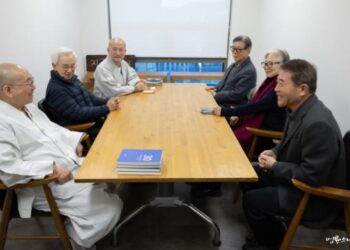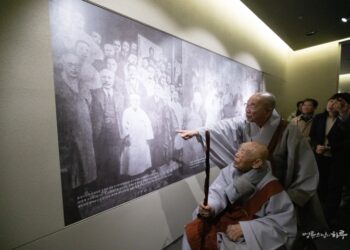March 9, 2025 – Day 21 of the 100-Day Dharma Talk, Meditation, Main Course Entrance Ceremony
Hello everyone. Today is the 21st day of Venerable Pomnyun Sunim’s 100-Day Dharma Talk. Today is the entrance ceremony for students who have registered for the main courses of the 100-Day Dharma Talk: Jungto Buddhism Course, Sutra Course, and Buddhist Social Studies Course. This morning, Sunim guided meditation for the participants, and in the afternoon, he conducted the entrance ceremony for all main courses.

After completing the morning practice and meditation, Sunim headed to the Jungto Social and Cultural Center at 10 AM. In the Dharma Hall on the third floor, about 350 people were sitting cross-legged, ready for meditation.
After the participants requested Dharma teaching with three bows, Sunim began by providing guidance on the proper meditation posture.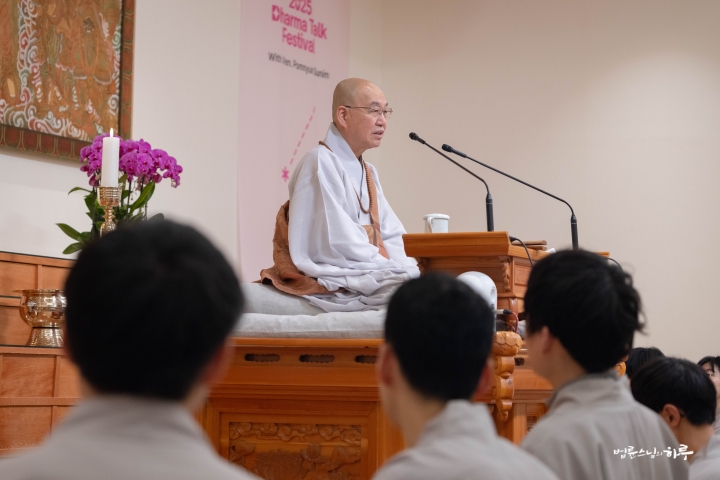
“Religion places great importance on faith. Faith is like a virtual world—it feels real to believers but appears illusory to non-believers. Science, on the other hand, doesn’t simply believe in something but questions it and verifies whether it’s true. The process of verifying facts is inquiry. A practitioner is someone who investigates whether many things we have believed until now are actually true.
The Buddha was participating in farming when he saw a bird pecking at an insect. He wondered, ‘Why must one being die for another to live? Is there a way for all to coexist?’ He asked his teacher about this, but the teacher replied, ‘Competition between two beings is a natural principle. Our remaining task is to figure out how to win.’ In fact, all disciplines ultimately contemplate ‘how can I win?’ ‘How can I benefit more?’ ‘How can I achieve what I want?’ ‘How can I win in competition?’ We accept these questions without any doubt and live accordingly. For example, when schools rank students, hardly anyone questions, ‘Why do we rank students?’ We simply accept that schools are meant to be that way.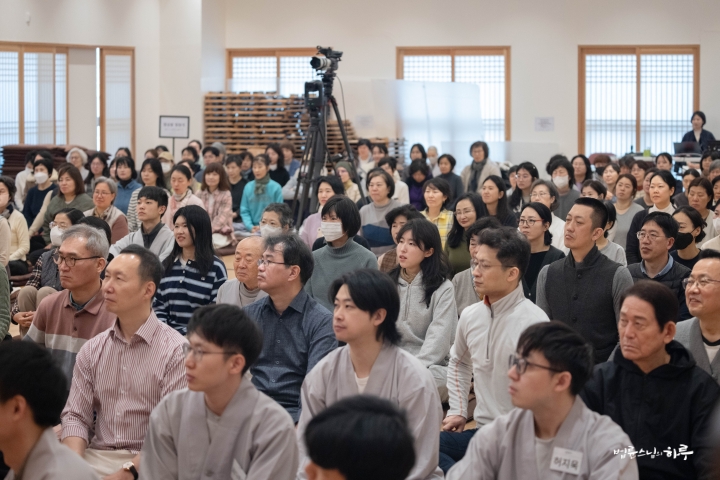
Why Do We Meditate?
In religious contexts, questioning “why we should do something” is often considered an obstacle to faith. It’s viewed as disbelief and a barrier to devotion. However, in science, questioning is regarded as the most crucial element of inquiry. The same applies to practitioners of meditation. Philosophers, too, must explore with the question “why?” When scientists inquire with such questions and form hypotheses, they must then prove them—either mathematically, through experimental evidence, or through observation. Only then can something become a law. Philosophers examine whether there are logical contradictions, and if none exist, they provisionally accept it as a principle. However, meditation practitioners must not only ensure that principles are logically consistent but also directly experience them with body and mind. No matter how much one knows about Buddhism or how well one can explain it logically and scientifically, without direct experience, one cannot resolve life’s problems. This is similar to how a scientific theory cannot be recognized as valid science without securing evidence through experimentation.
I’m emphasizing this because while learning and understanding the Buddha’s teachings is very important, directly experiencing them is paramount. When you sit and understand or contemplate with your intellect alone, that is not experience. We constantly focus on understanding what we don’t yet comprehend. Simply understanding something that was previously unclear is certainly a significant achievement. However, it’s like understanding a theory without having proven it through experimentation.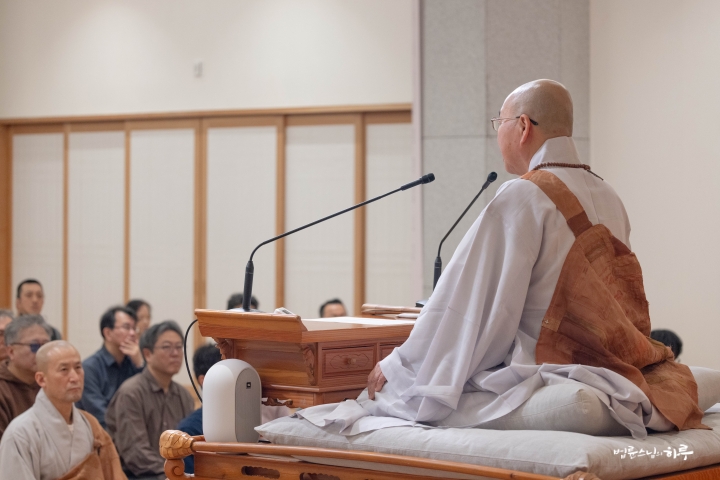
Meditation is theoretically simple. However, hearing and understanding principles and teachings is only the first step in practice. The process of experiencing it yourself is essential. For example, when a basketball player practices, whether the ball goes in or not isn’t particularly important. If the ball goes in, they retrieve it and shoot again. If it doesn’t go in, they still shoot again. If they’ve committed to practicing for 30 minutes, they shoot for the entire 30 minutes. With continued practice, someone who initially made 10 out of 100 shots might improve to 15 after a month, and 20 after a year. But even world-class players rarely make 100 out of 100 shots. We shouldn’t evaluate ourselves by thinking, “I have no skill” if we miss all 100 shots, nor should we clap our hands and exclaim, “It went in!” as if we’ve mastered everything after making just one shot. We also shouldn’t say, “Everyone’s the same!” just because both this person and that person sometimes make shots and sometimes miss them.
Being Awake Here and Now
The difference between a beginner who makes 1 out of 10 shots and a professional who makes 9 out of 10 is simply the result of practice. Spiritual practice also requires consistent effort. It doesn’t end with hearing and understanding the Buddha’s teachings; it requires direct experience. This is what we call “dedication to practice.” It’s not about intellectual contemplation but experiencing directly with our body and mind. Even the pain in your legs during meditation is something happening right now. It’s not happening in your imagination. Thinking, “Sunim gave a good Dharma talk yesterday” is happening in your imagination now. “I had tea with my mother yesterday” is also something that has already passed. “What will I do tomorrow?” is something in your thoughts that hasn’t yet occurred. But breathing in and out is happening right now. Practice is about “being awake, here and now.”
Yet we are constantly lost in thought. Practice means temporarily stopping those thoughts and being awake in the present moment. It’s about being aware of the breath happening in your body right now. If the inhaled breath doesn’t go out, you die; if the exhaled breath doesn’t come back in, you also die. Everyone who is alive breathes in and out, and practice is simply being aware of this. It’s not difficult. Don’t move, don’t wiggle even a fingertip, don’t think. There’s nothing to do. Nothing to research. Just sit quietly in a comfortable state and feel your breath. Now, let’s practice. 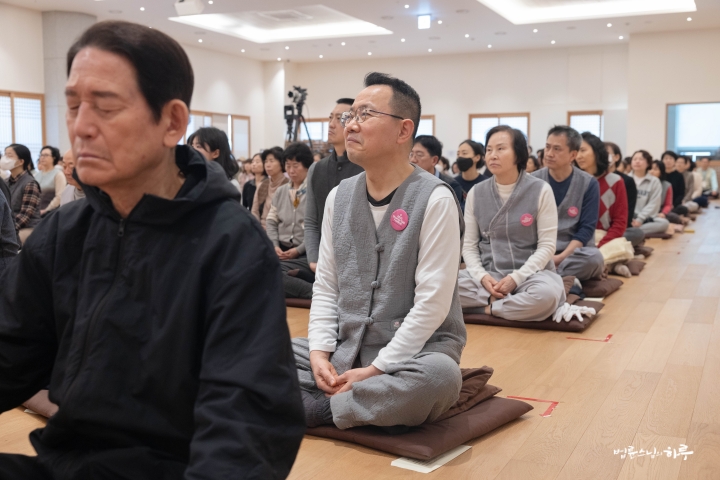
As soon as Sunim finished his guidance, meditation began with the sound of the wooden clapper.
“Tak, tak, tak!”

After 30 minutes of meditation, the wooden clapper sounded again.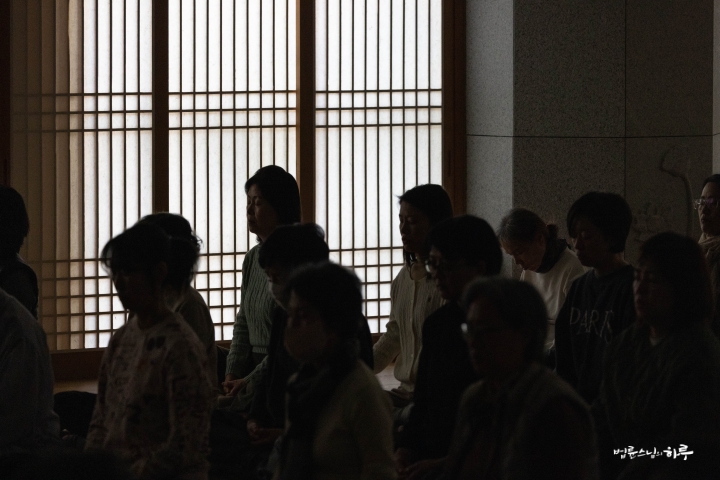
Sunim led a 10-minute walking meditation. During this time, the focus was on being mindful of posture and movement.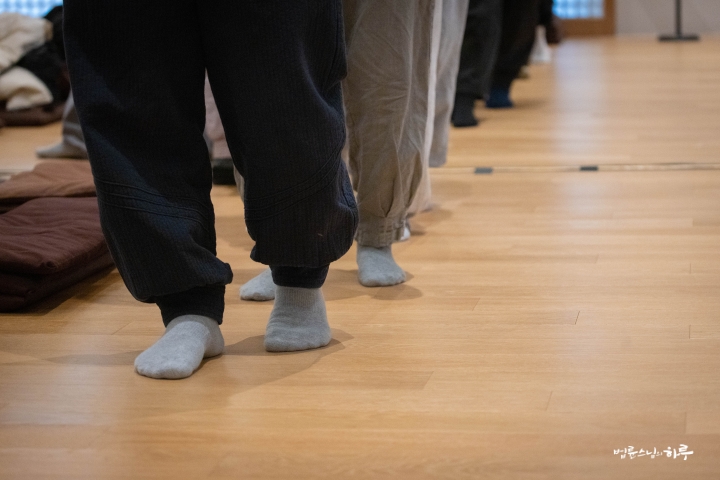
Following Sunim’s guidance, everyone sat down again to continue meditation.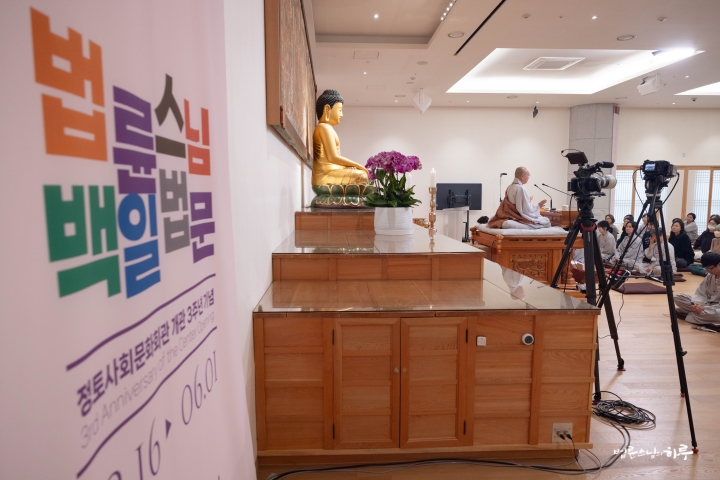
“In a comfortable position, focus your mind on the tip of your nostrils and be mindful of your inhalation and exhalation. When breathing in, be aware that you are breathing in, and when breathing out, be aware that you are breathing out. Be mindful that you are breathing here and now. If you lose focus, simply return to your breath.”
Another 30-minute meditation session followed.
“Tak, tak, tak!”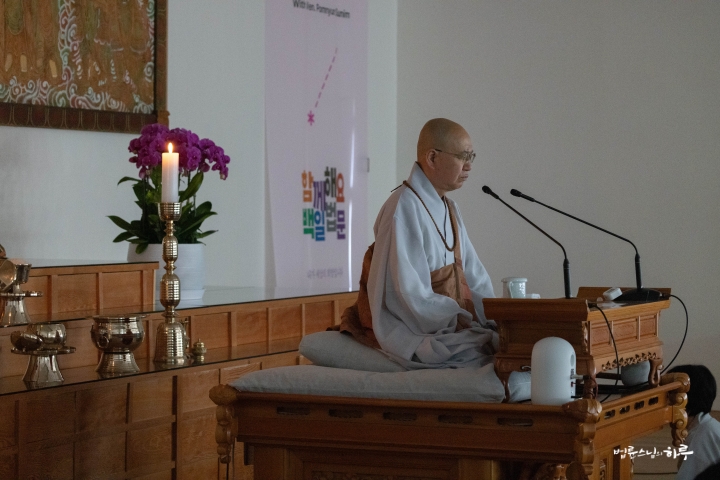
Today, the meditation concluded after three 30-minute sessions.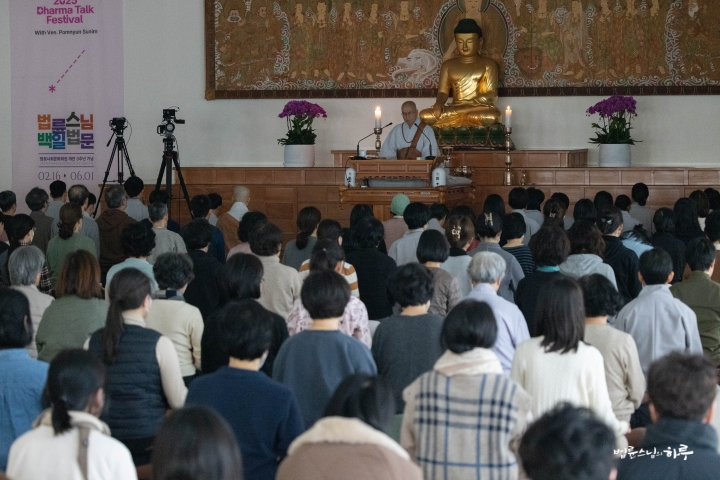
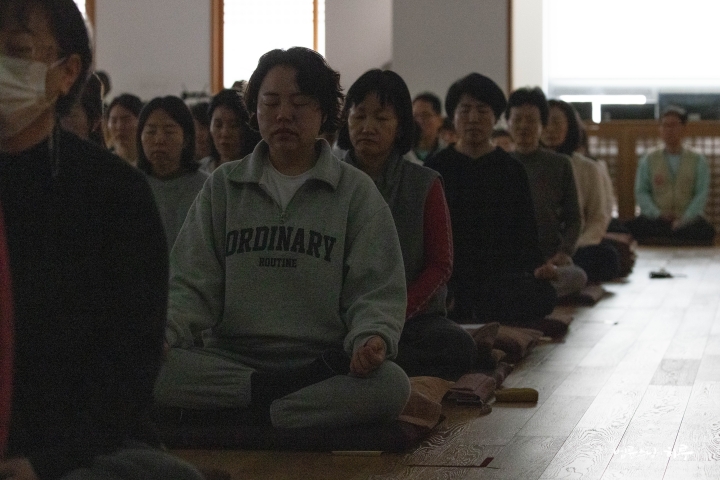
While the participants gathered in small groups to share their thoughts, Sunim had lunch and then at 2 PM, began the opening ceremony for the 100-Day Dharma Talk main course participants at the broadcasting studio of the Jungto Center.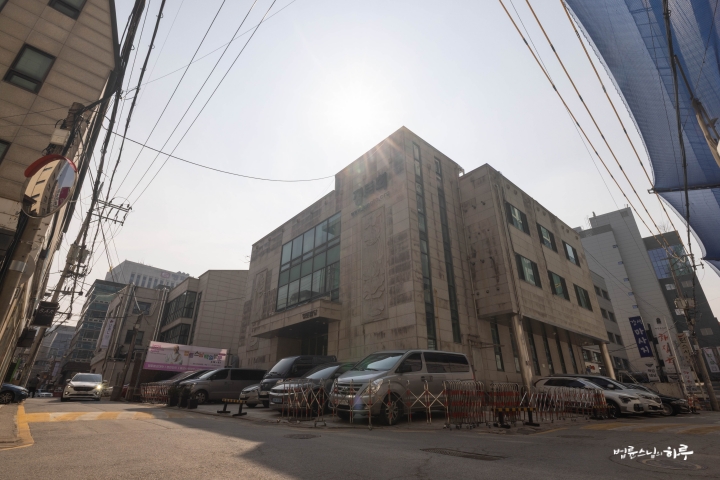
After reciting the Three Refuges and Words for Practice, there was a celebratory performance followed by time for new students to share their thoughts. One representative from each of the Jungto Buddhism Course, Jungto Sutra Course, and Buddhist Social Studies Course spoke about their expectations.
“I want to learn how to be happy and become someone who can contribute to the world, even in small ways. I hope to free myself from selfish desires and live in peace and harmony with those around me.”
“I’ve enrolled with the mindset of starting a new journey of learning, even though I’m over fifty. I’m especially glad to be studying alongside fellow practitioners.”
“Ten years ago, I was attending the Sutra Course when I became pregnant, and my due date coincided with the graduation ceremony, so I couldn’t attend. This time, I’ve re-enrolled hoping to complete the course successfully through to graduation.”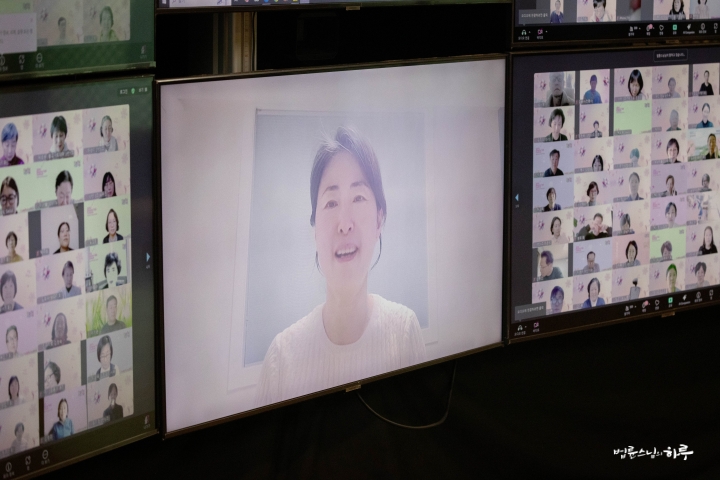
After hearing these brief remarks, the President of Jungto Society gave a welcoming address. For this 100-Day Dharma Talk main course, approximately 960 students enrolled in the Jungto Buddhism Course, about 800 in the Jungto Sutra Course, and around 2,200 in the Buddhist Social Studies Course. With about 4,000 people connected to the live broadcast, everyone respectfully requested Sunim’s opening Dharma talk with three full bows.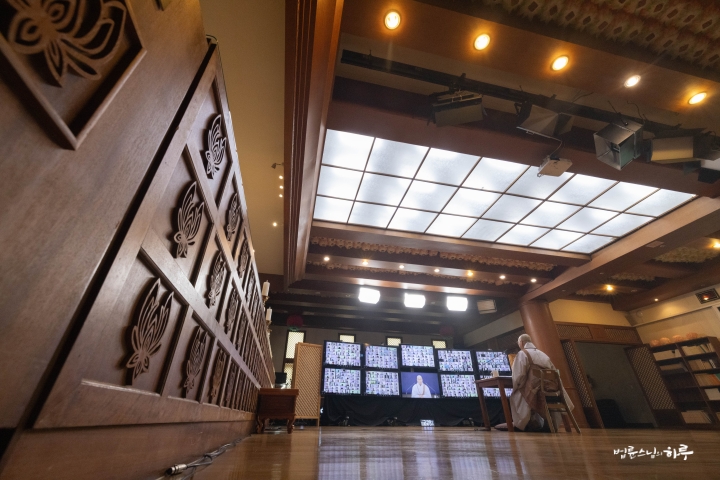
Welcoming the new students, Sunim provided an overview of what would be covered in each course—the Jungto Buddhism Course, Jungto Sutra Course, and Buddhist Social Studies Course—and discussed the mindset with which students should approach their studies.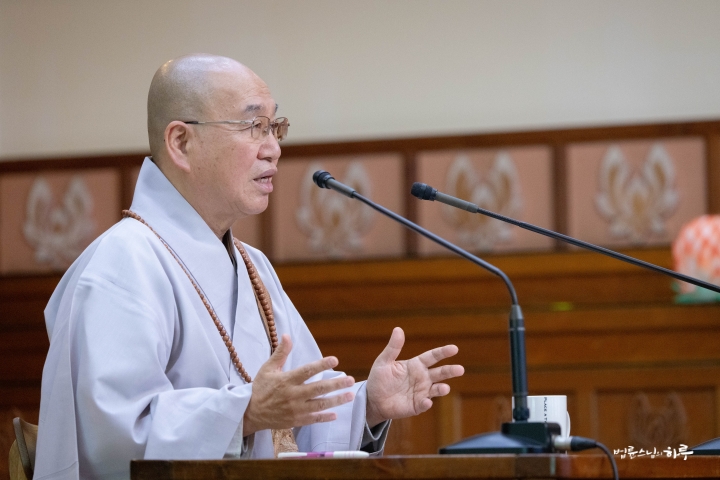
“Today marks the beginning for all students enrolled in the Jungto Buddhism Course, Jungto Sutra Course, and Buddhist Social Studies Course. Over the next 12 weeks, there will be a total of 23 lectures. While the teachings will primarily focus on Buddhism, what we’re truly seeking through these lectures isn’t just stories about the past or Buddhism. The purpose of these lectures is to find answers to questions like ‘How should I live my life?’ and ‘In what direction should our world move forward?’
Jungto Buddhism Course: The Path to Living as the Master of Your Life
First, the Jungto Buddhism Course is for those who are new to Buddhism. The curriculum is divided into two main parts: the fundamental philosophy of Buddhism and the life of the Buddha. In the first part, ‘Fundamental Philosophy of Buddhism,’ we will primarily explore how to awaken from ignorance and live as the master of your own life. Regardless of whether you live alone or with others, have children or not, work at a job or not, the fundamental philosophy of Buddhism teaches how to live without suffering. 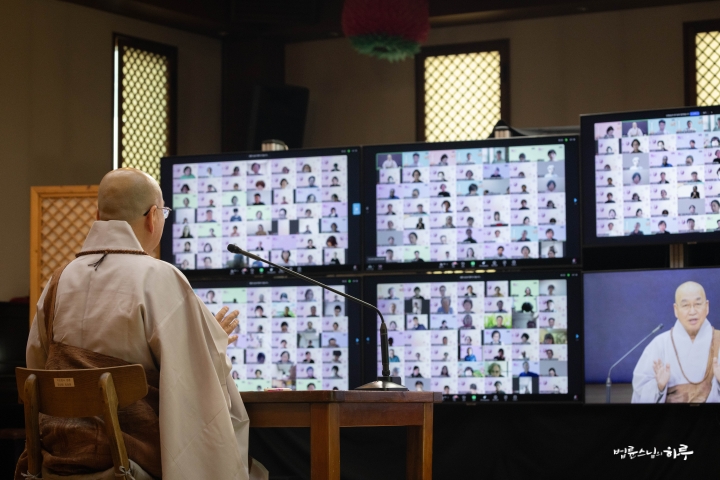
For the past 20 years, South Korea has maintained the highest suicide rate among OECD (Organization for Economic Cooperation and Development) countries. A high suicide rate indicates how difficult it is for people to live in the present. Additionally, South Korea has the lowest birth rate among the 38 OECD member countries. A low birth rate suggests that people believe life will be difficult in the future as well. Looking back at the past 60 years, despite economic growth and the establishment of a democratic society, these problems cannot be solved by economic development alone. The core of the Buddha’s teachings is to explore whether there is a way to live without suffering, and if so, how to achieve it. Buddhism is not about hoping for a better place after death or praying for blessings.
In the second part, ‘The Life of the Buddha,’ we will examine in detail how the Buddha attained enlightenment in the society of his time and how he lived after his enlightenment. The Buddha awakened on his own and reached a state of freedom without suffering. Not only did he live without suffering himself, but he also helped many others who were suffering. However, during the Buddha’s lifetime, there were all kinds of issues similar to those in our society today—the grief of a mother who lost her child, war, caste discrimination, gender discrimination, and so on. The Buddha’s country of birth was even defeated and nearly annihilated by a powerful nation. By examining how the Buddha viewed and lived in such circumstances, we can gain wisdom about how we should view and live in our world today. 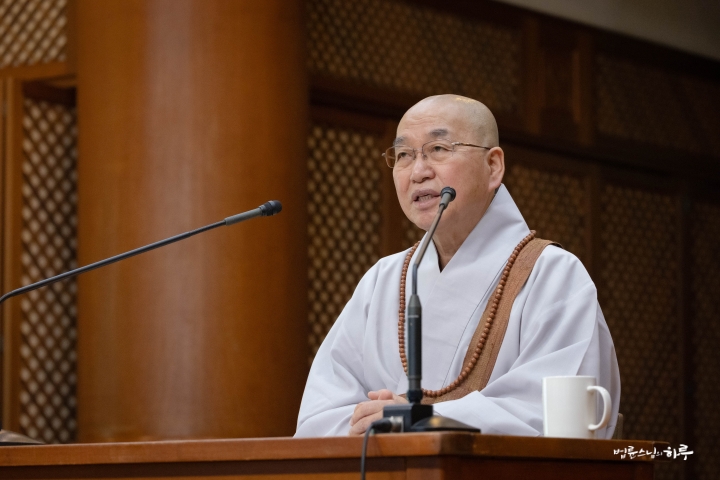
Sutra Lectures: Examining Buddhism from a Scientific Perspective
Next, the sutra lectures primarily cover content from Mahayana Buddhist scriptures. Buddhism has Hinayana and Mahayana traditions. There are also Vajrayana and Seon Buddhism, with Korean Buddhism being both Mahayana and Seon. The content covered in these sutra lectures includes the Diamond Sutra and the Heart Sutra, both Mahayana texts. The Diamond Sutra lectures can be described as an in-depth, repetitive study of “How can I maintain a mindset that allows me to live peacefully in reality?” The Heart Sutra lectures examine the commonalities and differences between the Buddha’s teachings and modern science. As science has advanced, contradictions in religions have emerged, leading to a rapid decline in religious populations. However, when examining the Buddha’s teachings from various perspectives of modern natural science, we find they contain no logical contradictions and remain rational. Although the Buddha did not specifically research the material world, aspects of his teachings align with modern scientific theories such as quantum mechanics. In this sense, the Heart Sutra lectures can be considered teachings for intellectuals.
Buddhist Social Studies: Reflecting on Various Social Issues Facing Humanity
Finally, Buddhist Social Studies is a course that examines the many social problems we face today. The first unique situation that our ancestors never experienced is the climate crisis. The climate crisis occurs as our excessive consumption causes temperature increases, changing ocean currents and wind patterns. This crisis brings changes to many species on Earth. Among them, humans—the apex species that evolved according to the current climate—face the greatest threat. Therefore, from the perspective of the Buddha’s teachings, we will discuss what causes the climate crisis and what perspective we should adopt. 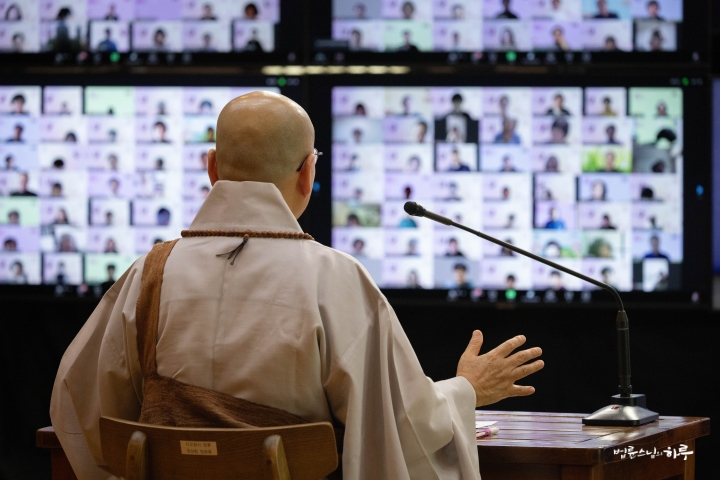
The second issue is the collapse of world order. After World War II, the United Nations was established, and various international orders were built through mutual agreements. The United States was at the center of building a “one world” system by overcoming differences. However, with the election of President Trump in the United States, the existing world order has been dismantled, throwing the entire world into confusion. If countries start pursuing self-preservation, the probability of conflict and war increases significantly. Therefore, we will address how we should respond to this uncertain future.
The third issue is polarization. While wealth disparity has existed in every era, it may be at its most extreme now. In the past, the assets of the top 10 percent matched those of the bottom 90 percent, but now the gap has widened to where the assets of the top 1 percent match those of the bottom 99 percent. Additionally, with the rapid development of science and technology, new technologies like artificial intelligence and quantum computers are approaching at an unimaginably fast pace. There is a risk that polarization will accelerate not only between countries with technological gaps but also within our society depending on who utilizes new technologies.
We cannot predict how significantly these unprecedented problems will impact our society in the future. They might even collapse ethics and morality, demanding entirely new perspectives. Moreover, absolute poverty and various forms of discrimination still persist throughout the world. Perhaps during such periods of change, existing problems may intensify. As the world generally becomes more conservative, there is a risk of regression on many controversial issues such as abortion rights, homosexuality, religious ideologies, and left-right ideological conflicts. Of course, conversely, crisis could also become opportunity. 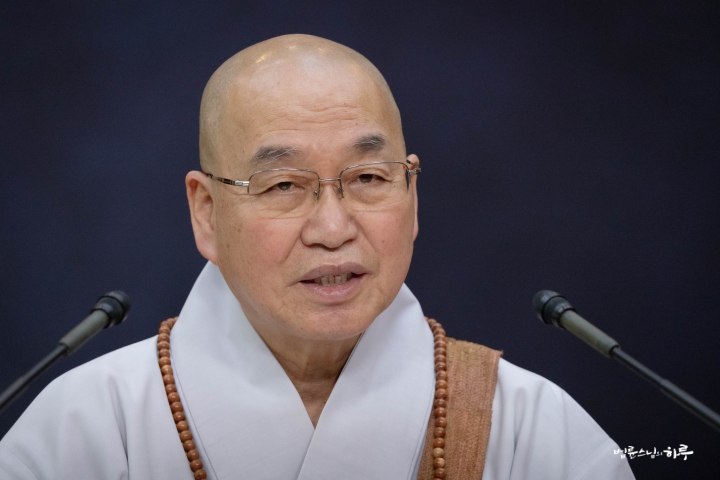
While the consequences of polarization have previously meant that wealthy people could build larger houses and eat better food, in the future, with the development of new medicines, the wealthy may be able to slow down aging, creating differences in lifespan as well. If this happens, human society will enter a completely different phase from the world we have known. I would like to discuss how we should understand and accept these issues from the perspective of the Buddha’s teachings. I also want to explore how things might change in the future and find ways to respond. First, we need to understand the world; second, have hope for solutions; and third, explore practical actions we can take toward that hope.
Regarding contentious social issues, you might feel uncomfortable or unwilling to listen because of your existing beliefs. However, I ask that you don’t avoid any topic. Even if you’re not interested or disagree, please don’t give up halfway through. After engaging in dialogue for the full 100 days, it’s not too late to draw your conclusions. I hope this can be that kind of time for us.” 
After completing the entrance Dharma talk, Sunim took time to hear participants share their brief impressions about attending today’s entrance ceremony.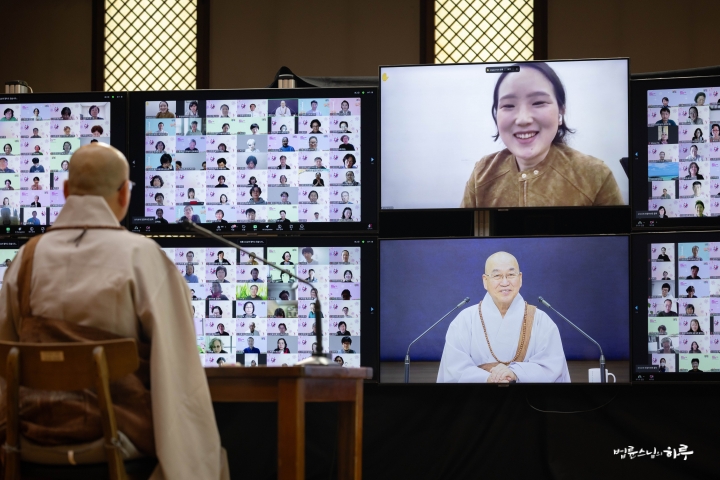
“Society is quite chaotic these days. I enrolled in the Buddhist Social Studies Course because I want to understand what perspective I should have and what role I should play in this situation. I will study diligently to become someone who can contribute to society.”
“After listening to Sunim’s Dharma talk today, I’m even more excited about the classes. I will strive to not just learn but also put the teachings into practice.”
“I tried reading the Diamond Sutra on my own, but the content was too difficult, so I signed up for the Sutra course. I’m looking forward to Venerable Pomnyun Sunim explaining it in an accessible way.”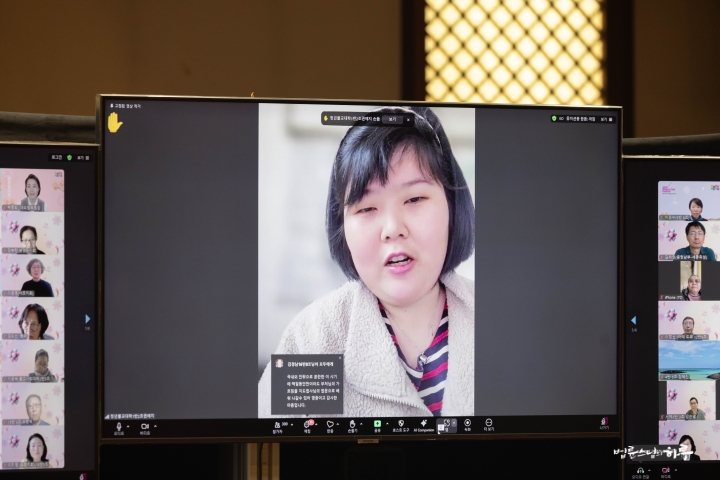
It was evident that all new students attended the entrance ceremony with hearts fluttering like the spring breeze. After freely listening to several impressions, Sunim concluded the entire entrance ceremony with a promise to meet again for the first class tomorrow.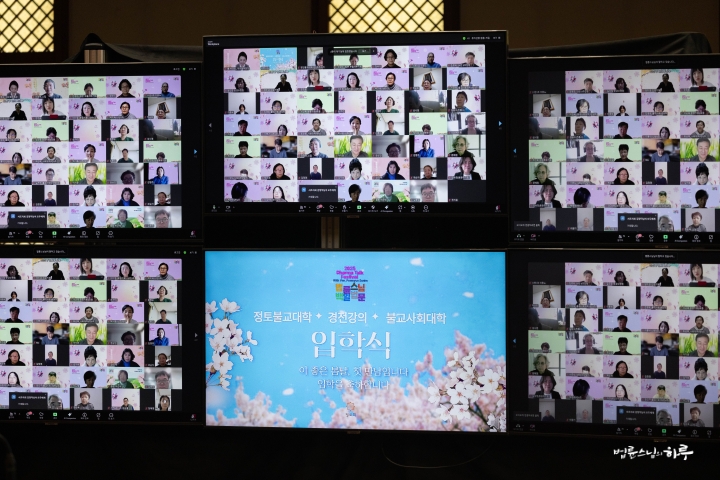
All participants entered their group video conference rooms for initial greetings and self-introductions, while Sunim left the broadcasting room.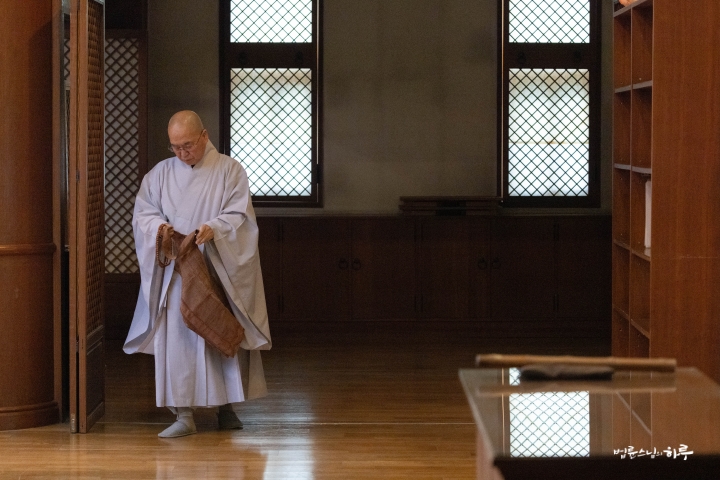
As the sun set, Sunim spent the evening handling office work and proofreading manuscripts before concluding the day’s activities.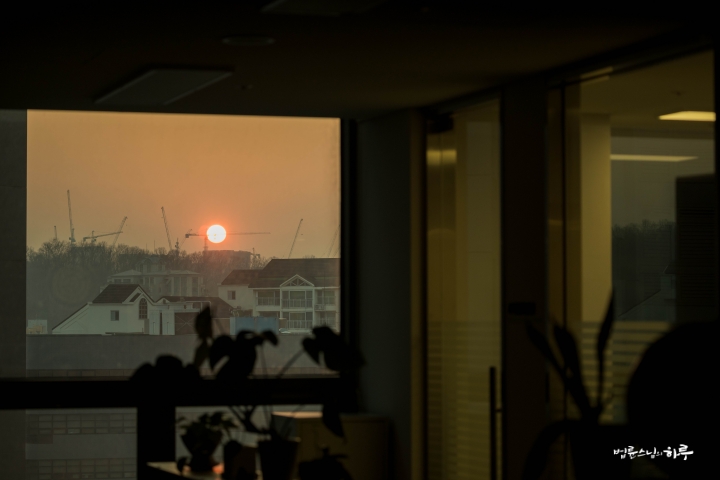
Tomorrow will be the 22nd day of the 100-Day Dharma Talk, when the main lectures finally begin. In the morning, Sunim will deliver the first Sutra lecture at the Dharma Hall on the third floor of the Jungto Social and Cultural Center, and in the evening, he will conduct the first Buddhist Social Studies Course lecture in the main auditorium in the basement.



